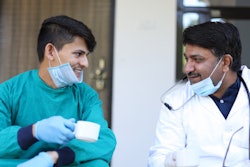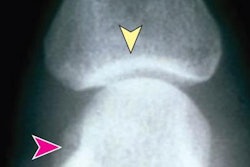
Nearly every patient's story involves imaging at some point along the journey. In fact, U.S. hospitals and health systems conduct more than 80 million CT scans every year, not to mention the number of x-rays, MRIs, ultrasounds, and nuclear studies that round out the imaging department.
 Calum Cunningham.
Calum Cunningham.Dealing with the sheer volume of work, particularly in a time when teleradiology has "soared" due to the pandemic, creates a series of challenges for radiologists, from extensive and time-consuming documentation requirements to optimally prioritizing a worklist. And at the end of the day, burnout has become a nearly universal experience.
A recent article in the American Journal of Roentgenology explored burnout through a series of conversations with practicing radiologists. One provider explained that the intensity of work is driving burnout; another said the more serious problem is "failing to work well."
But one radiologist shared a particularly striking perspective, saying: "Forgetting the patient behind the pixel contributes to depersonalization, and our work becomes less fulfilling."
Indeed, the radiologists who analyze, interpret, and report on patient images become part of the care team, helping to detect, diagnose, monitor, and ultimately treat medical conditions. Maintaining a focus on the patients and their outcomes, therefore, is essential to supporting a more fulfilling experience for radiologists.
To do their important work effectively, radiologists depend on a range of technological platforms to integrate images, relevant patient data, and even artificial intelligence (AI) services from across the healthcare ecosystem.
When a radiologist reads a mammogram, for example, he or she needs more than just the images from the patient's most recent study. The patient's previous images, information from the medical record (e.g., history, demographics, and symptoms), and -- increasingly -- AI-powered diagnostic models are all essential to helping the radiologist accurately, comprehensively, and efficiently prepare a report for the physician and patient.
The siloed nature of all these information sources means that retrieving and integrating them into one workflow can prove to be a challenge -- and one that may prevent radiologists from doing their work well. That's where an integrated workflow network, supported by AI, plays a role in delivering workflow efficiencies for radiologists while also supporting improved patient outcomes.
An integrated imaging network breaks down those siloes to connect imaging stakeholders and enable sharing of imaging and patient data within the radiologist's existing and familiar workflow. Likewise, the network integrates AI-powered diagnostic models, task automation, clinical decision support, and communication tools to help radiologists manage their growing workloads without sacrificing accuracy or quality.
Consider the impact of automating repetitive and mundane tasks, such as autotext options and macros for creating reports. Today's technological solutions can automate even further, enabling the application of AI-generated insights to support diagnosis, as well as allowing radiologists to depend on AI to help process imaging studies and automatically insert detailed data directly into the radiology report.
Likewise, AI can be applied within the workflow to automatically prioritize the reading room worklist. Imagine a stroke center with protocols and requirements for how quickly imaging must be completed and reported upon. If care is delayed due to a prioritization error, that has a tremendous impact on the patient's outcome. Instead, the integrated workflow network can not only prioritize these cases but also help the radiologists easily access the patient's critical data to inform a more comprehensive, accurate report that facilitates better care and treatment.
The impact, finally, of an integrated workflow in this way is to free the radiologist to focus on what matters most and, significantly, the aspects of work that are most fulfilling and instill a sense of purpose.
In short, it's less about driving productivity improvements (although that's certainly important), and more about maximizing every radiologist's effectiveness and value by centering the patient and their needs within the workflow.
Calum Cunningham is senior vice president and general manager of healthcare diagnostic imaging at Nuance Communications.
The comments and observations expressed are those of the author and do not necessarily reflect the opinions of AuntMinnie.com.



















